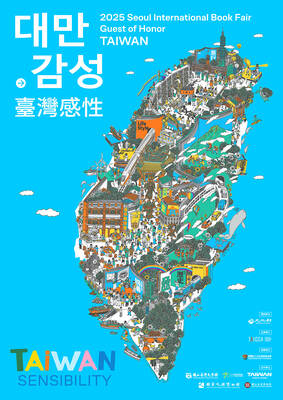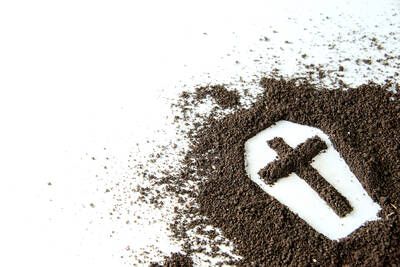Efflorescence — the breakout of gray lines on a wall caused by the crystallization of salt within the brickwork — is nothing but an annoyance for most people. But for Tung Huei-ping, an architectural designer from Ershuei Township in Changhua County, it is a medium for painting. He has used the different hues of the efflorescence lines on his living room wall to create a Chinese landscape painting, getting rid of the efflorescence and giving the wall a unique style.
“If you can beat it, you may as well use it to your advantage,” was the philosophy behind Tung’s idea. In the beginning, Tung tried various ways to cover up the efflorescence, but all his attempts were in vain. Tung later learned to live with the efflorescence and gained inspiration for his artwork from it. He now uses the idea of doing an ink and wash painting on a wall in the yard designs he does for his clients and says that the efflorescence has inspired his artwork.
Tung lives in an old house that is about 40 to 50 years old and about 10 years ago a wall of his living room started to show signs of efflorescence about the size of a palm. In the beginning, he just ignored it, but the efflorescence continued to worsen and in the end, the two-meter-wide wall was almost totally covered in efflorescence. The sight of this wall upset him and he used thick masonry paint to cover it up. However, a year later, the efflorescence had once again eaten its way through the white paint.
The white and gray lines of the efflorescence continued to multiply on his wall and at the start of last year, Tung suddenly saw how the different shades of color looked like a Chinese landscape painting of far-away mountains painted using the “splash ink” technique from Chinese landscape painting. He had a sudden flash of inspiration so he took out his Chinese calligraphy brush and composed a Chinese landscape painting along the efflorescence lines.
Tung said that it took 10 to 20 years for the wall to accumulate the efflorescence necessary to turn it into a Chinese landscape painting. He also said that when the efflorescence just started to show itself, he always felt troubled by it and thought it did not look good, especially when he had guests over. After trying to get rid of it several times, he thought that instead of fighting with the wall, he should value its existence and in doing so made it into a beautiful piece of art.
Tung said he has transformed something ugly into something beautiful and because he often has to design houses for other people, he must look for inspiration in everyday life. Tung said that when he recently designed a yard for a mansion more than 200 ping in size, he incorporated a landscape painting onto one of the walls and then embellished it with conifers known as the Kusamaki or Inumaki. Tung accredits the idea behind this design to that wall full of efflorescence that he turned into a landscape painting.
(LIBERTY TIMES, TRANSLATED BY DREW CAMERON)
惱人的壁癌該如何處理?二水鄉建築設計師董輝評把壁癌當作繪畫素材,利用壁癌斑斕的紋路創作中國水墨畫,不只壁癌消失於無形,還營造出牆壁獨有的風格。
「搞不定它,就反過來利用它」,董輝評起初用多種方法掩蓋壁癌,
結果白忙一場,後來學會與壁癌共處,還從中獲得創作靈感,後來他還把牆壁的水墨畫運用在庭園設計,他說,壁癌帶給他建築創作的靈感。
董輝評住的是四、五十年的老房子,約十年前客廳牆壁出現約手掌大小的壁癌,起先放任不管,後來面積逐日擴大,兩公尺寬的牆壁幾乎都被壁癌攻佔,連自己看了都不舒服,他用厚厚的水泥漆覆蓋,隔年壁癌又吃掉白色的漆彩。
白一塊、灰一塊的壁癌任它肆無忌憚的在牆上孳長,去年初董輝評乍見斑斕紋彩,彷彿脫胎自中國水墨畫,一座座潑墨的遠山浮現眼前,他福至心靈,趕緊拿出毛筆,靈感泉湧而來,順著壁癌的紋路畫出一幅山水畫作。
董輝評說,這個「癌細胞」累積一、二十年的功力才能成就一幅山水畫作,壁癌剛出現時,他心理總會起疙瘩,覺得有客人來時,看到這樣的牆壁總是不體面,幾番對抗都徒勞無功,心想,與其對抗惱人的「癌細胞」,不如正視它的存在,於是利用彩筆把它融入生活中,反而更美觀。
他說,這也算是化腐朽為神奇,由於他經常要幫人設計房子,總要在生活中尋找靈感,他最近設計一間兩百坪豪宅的庭院,就把牆上的山水畫作融入其中,再以羅漢松點綴其間,整個創作的思維都是來自那面壁癌山水牆。
(自由時報記者顏宏駿)

The 2025 Seoul International Book Fair was held from June 18 to 22 at the COEX Convention & Exhibition Center in Seoul, South Korea. This year, participants from 17 countries attended, with over 530 publishing houses and related organizations taking part. For the first time, Taiwan participated in the book fair as the Guest of Honor, bringing together more than 85 publishers and presenting a curated selection of 550 titles. A delegation of 23 Taiwanese creatives traveled to Seoul to attend the event, including 13 literary authors, six illustrators, and four comic book artists, among which were a film director, an

In late 2024, the suicide of acclaimed Taiwanese author Chiung Yao at 86 sparked a societal debate. She expressed her desire to avoid the difficult aging process and sought to govern her own death rather than leave it to fate. Her statements propelled the issue of “euthanasia” back into the public arena, posing the question of whether Taiwan should legalize euthanasia to grant patients and the elderly the right to die with dignity. Euthanasia, the intentional ending of a life to relieve suffering, is legal for humans in countries like the Netherlands and Belgium but remains prohibited in Taiwan.

A: Wow, the 36th Golden Melody Awards ceremony is set for this weekend. B: I like all the nominees for Best Mandarin Album: Incomplete Rescue Manual by various artists, Outcomes by J.Sheon, Invisible Color by Terence Lam, The Dreamer by Khalil Fong, Haosheng Haochi by Trout Fresh and Ordeal by Pearls by Waa Wei. A: Despite struggling with serious illness, Fong managed to finish his last album before he died. B: With his hit Twenty Three, he is also nominated for Best Song, Lyricist and Composer, and will receive a Special Jury Award for his album. A: And

Continued from yesterday(延續自昨日) https://www.taipeitimes.com/News/lang As Gen Beta grows, they are expected to witness advanced technologies becoming fully integrated into various fields like education, workplaces, healthcare and entertainment. In addition to technological developments, they will also face big challenges like severe climate change. Influenced by their Gen Y or Gen Z parents, who view climate change as a critical issue for the future and prioritize sustainability, they are likely to focus more on global issues and seek innovative solutions to address them. Moreover, Gen Beta will experience considerable demographic changes, such as lower birth rates and longer lifespans. Consequently, Gen Beta is predicted to